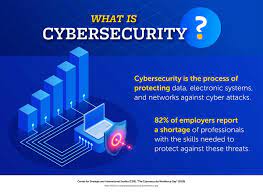Safeguarding the Digital Frontier Exploring the Vital Role of Cybersecurity

In our increasingly interconnected and digitized world, the importance of cybersecurity cannot be overstated. As technology continues to advance, so do the threats to our digital infrastructure. Cybersecurity is not merely a technical necessity; it’s a critical aspect of safeguarding sensitive information, protecting individuals, and ensuring the resilience of businesses and nations. In this article, we delve into the multifaceted realm of cybersecurity, examining its challenges, strategies, and the evolving landscape of digital defense.
The Cyber Threat Landscape:
The digital landscape is rife with diverse and sophisticated threats, ranging from ransomware attacks and phishing scams to nation-state cyber espionage. As our reliance on technology deepens, the potential impact of these threats on individuals, businesses, and governments becomes increasingly severe. Cybersecurity is the shield that guards against unauthorized access, data breaches, and the disruption of critical services.
Key Components of Cybersecurity:
- Network Security: Protecting the integrity and confidentiality of data as it travels across networks is fundamental to cybersecurity. This involves implementing firewalls, intrusion detection systems, and encryption protocols to thwart malicious actors.
- Endpoint Security: As more devices connect to networks, securing individual endpoints (such as computers, smartphones, and IoT devices) becomes crucial. Endpoint security measures include antivirus software, firewalls, and device management solutions.
- Identity and Access Management (IAM): IAM ensures that only authorized individuals have access to specific resources. This involves implementing robust authentication processes, including multi-factor authentication, and managing user permissions effectively.
- Data Security: Encryption, tokenization, and data loss prevention strategies safeguard sensitive information from unauthorized access. Data security is paramount, especially in industries handling personal and financial data.
- Incident Response and Recovery: Cybersecurity is not solely about prevention; it’s also about preparedness. Establishing comprehensive incident response plans enables organizations to detect, respond to, and recover from security incidents efficiently.
Challenges in Cybersecurity:
- Cybersecurity Skills Gap: The rapid evolution of cyber threats has created a shortage of skilled professionals in the field. Bridging this gap is essential for maintaining effective defenses.
- Sophisticated Attacks: Cybercriminals continually refine their tactics, using advanced techniques such as social engineering and AI-driven attacks. Keeping pace with these threats requires constant innovation in cybersecurity measures.
- IoT Vulnerabilities: The proliferation of IoT devices introduces new entry points for cyber threats. Securing the expanding network of interconnected devices is a significant challenge.
The Future of Cybersecurity:
- AI and Machine Learning: Leveraging artificial intelligence and machine learning for threat detection and response is a growing trend in cybersecurity, enabling faster and more accurate identification of anomalous activities.
- Zero Trust Security Models: The traditional perimeter-based security model is evolving towards a zero-trust approach, where no user or device is automatically trusted, and verification is required from anyone trying to access resources.
- Collaborative Defense: Information sharing and collaboration among organizations, industries, and nations are crucial for a collective defense against cyber threats. The cyber landscape requires a united front to effectively combat evolving challenges.
Conclusion:
In the digital age, cybersecurity is not just a technical necessity; it’s a strategic imperative. As the guardians of the digital frontier, cybersecurity professionals play a pivotal role in protecting our data, privacy, and the critical systems that underpin our modern society. The ongoing collaboration between technology innovation and cybersecurity measures is essential to staying one step ahead of the ever-evolving threat landscape. Only through a comprehensive and dynamic approach can we truly secure the digital world for the generations to come.




